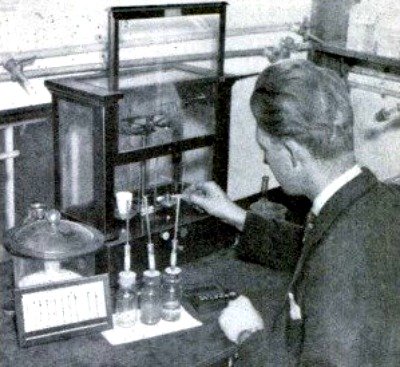Poison Murders Solved. Classic Article By William Wolf (1935)
Two men were sentenced to death early this year in India for a murder in which plague germs were rubbed into a pin-prick on the victim. Described as an "unparalleled example of diabolical ingenuity" at the trial, the murder method added another means of poisoning to the already long list crime investigators encounter.
Fascinating because they usually are committed with a cold precision not common to other slayings, poison murders offer to the new type of scientific detective ideal cases in which to employ analytical methods. With few exceptions, such murders are solved in the laboratory with skill that is uncanny to the layman.
"Forensic analysis" sounds harmless enough, but it is the science of toxicology brought to a high state of development at the Philadelphia College of Pharmacy and Science. Through it, the cunning of the poisoner is pitted against the skill of the analytical chemist and the murderer stand a poor chance of winning.
|
The clever devices employed in slaying with drugs and chemicals reveal that poisoning often is a deadly art. Unlike slaying with the knife or gun, poisoning offers a wide choice of vehicles in which to convey the death-dealing agent. The poisoner, in addition, is almost invariably of a higher mental type than the gunman or thug. For that reason, America can expect an increase in the number of poison murders, since a nation's homicidal deaths from drugs increase with the country's advances in refinement and culture. |
|
Chewing gum, sleeping powders, candy food, wine, beer and whisky, finger rings with syringes attached, specially constructed knives, medicines of all kinds - practically everything in everyday use has been employed for administering poison to a chosen victim.
It is the task of the scientific investigator to learn, first, if a death has been caused by a poison and, if so, to determine what poison was used and how it was administered.
Both results are achieved by analytical chemistry. The Philadelphia College crime investigator subjects portions of the victim's viscera, flesh, or brain tissue to a methodical process of chemical tests in which one type of poison after the other is sought. When the type is identified, the actual poison can be isolated. The same process is followed in the examination of the food, candy, or whatever is suspected of containing the poison.
The "poison-kiss" murder some years ago in Cumberland, Md., is an excellent example of how easily poison, once suspected, can be detected. In this amazing case, a young man and his fiancee were found seated on a sofa at her home, rigid in death, the morning before their wedding. The faces of both were flushed, and the man had suffered a slight oral hemorrhage. The external evidence, which often sets the chemical analyst on the right track at once, indicated cyanide of potassium.
In the man's mouth was found a piece of chewing gum and the remainder of the pack was discovered later at his home. A chemical analysis of the gum and stomach contents of both victims revealed the suspected potassium cyanide as the fatal agent. Tests for other poisons were made. None was found, and the case was closed from the toxicologist's viewpoint. Legally, the courts decided that the man had intended to kill only the woman but had underestimated the deadliness of cyanide and had swallowed some as he kissed her to convey the poison.
Such is the side of a story that the public knows. Behind it is the seldom mentioned laboratory work wherein the finger of science points unerringly to the active poison.
When a sample is brought to the Philadelphia College for investigation, it goes through a process that reveals the value of the toxicologist's testimony before a court. Nothing is left to chance. If a portion of viscera is submitted for analysis, the toxicologist keeps detailed notes of its receipt - where it was obtained, what it is, the time it was delivered, its condition and its weight. All this careful preliminary work is necessary if evidence is to be given in a trial. Defense lawyers are always alert of any loophole in such testimony.
The sample is divided into three portions. One is for reference should anything happen to the others, another is for qualitative tests to determine what kind of poison was used, and the third is for quantitative tests to learn the amount of the poison.
One sample is chopped into fine pieces. Arsenic, the poisoner's old favorite and stand-by for centuries, is sought first - not because it is the most common of poisons, but because the Reinsch test for arsenic, bismuth, antimony, and mercury can be readily applied. A piece of prepared copper will become stained by any of these poisons if it is boiled in a liquid with them. Each poison can be identified by a distinguishing test of the exposed copper.
A typical case of arsenical poisoning, which fortunately had no fatal results but in which the poison was detected by similar methods, occurred in 1934 near Philadelphia. A woman was charged which trying to poison her brother by sending him a box of fudge. The candy was dosed with arsenic, and six persons became ill after they ate it. The candy was analyzed and the poison detected. The woman was traced through the typed address on the package and a fingerprint.
The next step in the analysis of a sample is to look for volatile poisons, or those capable of being detected through distillation. The chopped-up sample, with liquid added, is heated in a flask. The vapors are condensed and the resulting fluid subjected to many tests. In the volatile group fall chloroform, ethers, alcohols, phenol, phosphorus, and most of the alkaloids. Tests are made for the non-volatile poisons, such as strychnine, luminal, and veronal, after the distillation. Finally, the metallic poisons are sought by destroying all organic matter through heat and leaving any possible metals in solution.
Inaccurate reports occasionally appear in the newspapers about some deadly poison that leaves no trace. Such stories are misleading, for the tests mentioned will reveal the presence of any chemical poison. There is only one recorded case in which poison defied detection and this was due to no fault of the toxicologists.
A young German scientist, Dr. Joseph Born, visited England in 1925 in an effort to sell a method for making synthetic alkaloids, such as atropine, cocaine, and nicotine, which would reduce their costs. His money ran short, no one seemed interested, and finally he took his own life. He left a note reading: "I must die by my own invention. Is it not funny?"
Qualitative tests such as those discussed should have shown what poison Dr. Born used. They didn't. Apparently he had invented the synthetic drugs and they left no traces when he used them, ironically to take his own life.
Obviously, where poison is not suspected, the poisoner has an excellent chance to escape. For that reason, the present practice is to have the man who will make the chemical analysis present at the autopsy in all suspicious deaths. There are many things about the victim's body that will indicate poisoning to him and often he is furnished with a clue that aids him in his analysis.
The arrow poison of South America, curare, is much favored by mystery-story writers as a toxic substance which is supposed to be quite baffling. But it would not deceive a Philadelphia College investigator. Curare falls into the alkaloid group and the investigator knows its action through experiments. Frogs, if injected with curare, are paralyzed in the voluntary and respiratory muscles. The heart continues to beat, but breathing through the skin is difficult. The same paralysis is noted in man and other warm-blooded animals.
Curare comes from the Strychnos family of plants, as does strychnine (Strychnos nux vomica). However, strychnine is a tetanus producing drug, causing violent muscular convulsions. A strychnine victim's body is arched in a bow while tremors ripple the muscles. Curare, on the other hand, produces quite the opposite effect, paralyzing the muscles.
Strychnine itself was used in the 1933 "poison-picnic" murder in Arkansas. It was administered in grape juice and, strangely enough, the beverage was taken by the four victims without their noticing anything unusual about it. Strychnine is extremely bitter, one part in 70,000 parts of water being distinctly noticeable.
A man, his wife, and two of their children were killed in this case by an attorney who feared the father was going to "squeal" on him in connection with a shady case. A third child lived and told of seeing the attorney "put something" in the grape juice. The "something" turned out, under qualitative tests, to be strychnine.
Poisons fall into distinct chemical classifications. Acids and alkalies form the first group. Among the former are such substances as sulphuric and hydrochloric acid. Among the latter are caustic potash and ammonia, with others. The metallic poisons like lead, silver, mercury, copper, arsenic and thallium salts are in a second group. Thallium sulphate was the poison fatal to five members of a New York family in May of this year. In this case, chemical analysis revealed the poison in cocoa used by the family. The gaseous poisons form another group and include the familiar carbon monoxide, five tenths of one percent of which in stagnant air can prove fatal. This means that in a garage of 200 cubic feet, one cubic foot of carbon monoxide would be fatal. Other gaseous poisons include hydrocyanic or prussic acid, chlorine, and others.
Hydrocyanic acid is swift in its action, one to two and one half grains being sufficient to cause death. It evaporates quickly, and a mere whiff of the fumes can bring death with dramatic quickness - but not with the speed mystery-story writers claim. Like all other poisons, hydrocyanic acid has different effects upon different persons and a Philadelphia College investigator is on the alert for the complications that often arise as a result.
A man could swallow hydrocyanic acid and, in the few seconds before death ensued, toss the bottle out the window, walk to a chair, and sit down. The odor of bitter almonds or peach blossoms, so stressed in mystery stories, would indicate the acid as the cause of death, but only the trained investigator would consider suicide when no bottle was found in the room. He would make a search outside the room, at least.
Nicotine, conine (which is the poison hemlock swallowed by Socrates), alcohol, ether, chloroform, formaldehyde, and allied compounds fall into a fourth group of volatile organic poisons. A miscellaneous group would include nitrobenzene, phenol (carbolic acid), and the aniline dyes, among others.
Substances seldom classed as poisons by the public, such as alcohol, chloroform, and ammonia, are included in the toxicologist's category, for anything capable of being taken into a living organism and causing by its own action impairment of the organism's function is a poison.
For this reason, the culture of septic-pneumonia bacteria used in the India case was classed as a poison. An interesting side light on that particular murder is the fact that the conspirators, who sought the victim's death so that his estate might be inherited by them, tried first to kill him with tetanus bacilli which were rubbed on the bridge of his spectacles.
Poisons in the several groups act in three ways. They are irritants, blood poisons, or nerve poisons. Pain, vomiting, and purging are produced by the irritants. In the blood poisons, the circulation is affected directly, the red corpuscles are destroyed, or the drug has a peculiar action on the coloring matter or decomposition products of the blood. The nerve poisons include the narcotics or stupefying drugs, those producing delirium, and those causing convulsions.
The scientific investigator knows the probable effect of each poison through experiment and experience and can identify them at the autopsy and later check in the laboratory. Tests on the lower animals help. Frogs are quite useful in determining the effects of poisons. The poison is injected into a frog's lymphatic gland and the heartbeats, respiration, and voluntary and involuntary movements are studied.
The examination of bloodstains plays an important part in scientific crime detection. While distinct from the forensic analysis of poisons, tests to reveal whether a blood spot is animal or human, or even to prove that it is blood at all, are often vital factors in the prosecutor's case.
Many factors enter into the study of bloodstains the material on which they are found, their age, and the condition of the material to which the blood adheres. Blood will form a compound with iron oxide, for instance, if found on rusty iron. Greasy cloth makes a bloodstain look like any other discoloration. The composition of bricks or plaster must be considered.
If there is a quantity of fresh blood, as in a pool, it can be tested for grouping - that is, compared with the four types of human blood and its animal or human origin determined. Or it can be placed under the microscope and the red and white corpuscles, which differ in humans and animals, identified.
If a stain is blood, there is a positive test that will reveal it as such. After the stain has been soaked off the cloth, wood, or other material holding it, chemicals are added to the solution and, if it is blood, the haemoglobin in it will crystallize into haematin crystals. These are readily identified under the microscope as chocolate brown needles, usually four-sided
Several chemicals, benzidene, ortho-tolidine, dine, guaiacum, and phenolphthalein, turn definite colors when hydrogen peroxide is added to them in the presence of a solution containing a trace of blood. All but the phenolphthalein become a beautiful blue color, while this exception turns red. These tests are so responsive that they reveal blood when it is present in only one part to 500,000 parts of solution.
The precipitin test makes use of serum from a rabbit which has been immunized against the type of blood to be tested. This is used to distinguish different kinds of blood. A rabbit immunized with chicken's blood will produce a serum that will react only when in contact with chicken's blood. If immunized with human blood, the serum is the proper reagent for only human blood. The investigator tests many kinds of prepared serums, in tubes containing blood solution. The right one liberates the coloring matter of the blood, which the others do not.
LEARN ALL ABOUT FORENSIC TOXICOLOGY
There is a page dedicated to forensic toxicology on the All About Forensic Science website which you can access via the following link.
Recent Articles
-
All About Forensic Science
Nov 12, 24 03:05 AM
A forensic science website designed to help anybody looking for detailed information and resources. -
The Role of Forensic Evidence in Criminal Defense Cases
Sep 05, 24 03:38 AM
Article exploring five key roles that forensic evidence plays in criminal defense cases -
The Evolving Role of Medical Science in Forensic Investigations
Aug 06, 24 03:35 AM
Insightful article exploring the critical role of medical science in forensic investigations.



New! Comments
Have your say about what you just read! Leave me a comment in the box below.